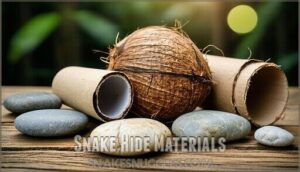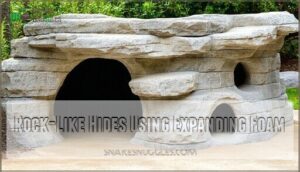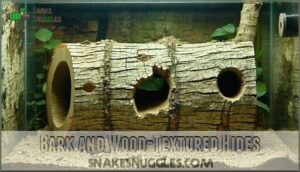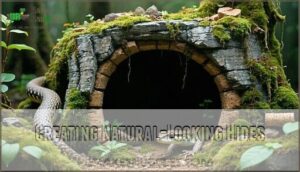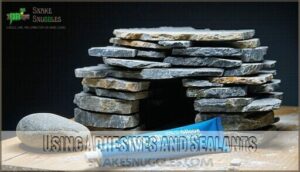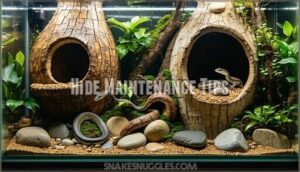This site is supported by our readers. We may earn a commission, at no cost to you, if you purchase through links.

Start with everyday items like small plastic containers, PVC pipes, or even sturdy cardboard. Cut an entrance hole (big enough for your snake but not too huge—they love snug spaces), and smooth any rough edges.
For a natural look, cover it with non-toxic spray foam or glue on some bark, moss, or even coconut fiber. Just guarantee good ventilation and avoid harmful materials.
Want to make it desert-style or mimic a jungle? The sky’s the limit—your snake will thank you for the new home!
Table Of Contents
- Key Takeaways
- Snake Hide Materials
- DIY Hide Designs
- Essential Hide Considerations
- Hide Box Techniques
- Hide Maintenance Tips
- Frequently Asked Questions (FAQs)
- What can I use for snake hide?
- What makes a good snake hide?
- Do snakes need two hides?
- What do snakes like to hide under?
- How to make a snake hide?
- How long does it take to make a snake hide?
- How do you hide a pet snake?
- Does plastic make a snake hide easier?
- Are snakes hiding in a homemade PVC snake hide?
- How do you hide a snake & lizard?
- Conclusion
Key Takeaways
- Use everyday materials like cardboard, plastic containers, or PVC pipes for quick and easy snake hides.
- Make sure your snake hide is safe, dark, well-ventilated, and snug for your pet’s comfort.
- Incorporate natural elements like bark, moss, or coconut fiber to create realistic and cozy designs.
- Regularly clean, inspect for wear and tear, and replace hides as needed to keep your snake healthy and happy.
Snake Hide Materials
When choosing materials for your snake’s hide, you’ve got plenty of options, from simple cardboard to durable plastic.
Just make sure the materials are safe, easy to clean, and sturdy enough to handle your snake’s instinctive exploring.
Cardboard and Paper-Based Materials
Cardboard and paper-based materials are brilliant starting points for DIY snake hides. They’re simple, affordable, and eco-friendly.
Here’s a quick list:
- Use cardboard boxes for temporary hides.
- Craft with paper mache—it’s durable and fun.
- Try toilet rolls for hatchlings or yearlings.
- Egg carton lids add cozy hiding spots.
Consider purchasing a pre-made cardboard hide for convenience.
- Make certain safe inks when reusing printed materials.
Plastic Containers and PVC Pipes
Plastic snake hides and PVC pipes offer durability, easy cleaning, and humidity control—perfect for any reptile habitat project!
Plastic containers and PVC pipes make excellent DIY snake hides. They’re durable, easy to clean, and fantastic for humidity control.
Just smooth sharp edges and double-check container safety before use. PVC pipe snake hides fit snugly in any reptile habitat DIY project, while plastic container hides provide simple enrichment for snake enclosures.
Consider pre-made options for convenience. They’re budget-friendly and versatile—you’ll love the results!
Spray Foam and Insulation Materials
Expanding foam works wonders for shaping custom snake hides, letting you carve caves or unique designs easily.
It’s versatile but guarantee full curing time for safety.
Insulation types like XPS foam are durable choices too.
Always use non-toxic sealants to avoid toxicity concerns.
Foam carving allows for endless creativity, making tough, cozy, and secure spaces for your scaly friend, providing a cozy environment.
Natural Materials for Realistic Hides
If spray foam feels too artificial, natural hides can bring the outdoors to your snake’s enclosure.
Try using bark or cork bark for their texture and durability.
- Look for untreated wood to guarantee safety.
- Different moss types can enhance natural aesthetics.
- Use sanded edges to prevent splinters.
Your snake gets comfort, you get a wild vibe.
For tropical species, consider moss and plants to enhance humidity.
DIY Hide Designs
Building your own snake hides is easier than you’d think, and it lets you create something that fits your pet’s needs perfectly.
Whether you’re shaping foam into a rocky cave or turning bark into a cozy hideaway, your creativity can go a long way in keeping your snake happy and secure.
Rock-Like Hides Using Expanding Foam
Sculpt your snake’s hide into a natural, rock-like cave—practical, stylish, and perfectly cozy for your scaly companion!
Using expanding foam gives your snake’s hide a rock-like appearance that’s both practical and stylish.
Start by sculpting the foam into cave shapes. Foam toxicity is a concern, so choose reptile-safe options.
Add texture by carving details and using tile grout. For durability and sealing options, apply non-toxic sealants.
Your DIY snake hide will look natural yet sturdy!
Bark and Wood-Textured Hides
Bark and wood create stunning, natural snake hides for your reptile. Choose pest-free bark and humidity-resistant wood for safety.
To build your DIY snake hide, follow these steps:
- Pick bark like cork or oak for its durability and natural aesthetics.
- Stack bark slabs or attach to wooden blocks.
- Add ventilation holes to prevent pests while enhancing your snake enclosure’s enrichment.
By using natural materials and following these instructions, you can create a safe and appealing environment for your reptile.
Moss and Plant-Covered Hides
To add a lush, natural vibe to your DIY snake cave, line it with soft moss and safe fake plants.
Focus on moss hydration to maintain humidity control while checking plant toxicity to guarantee safety.
Avoid root intrusion by securing plants firmly.
Aesthetic appeal isn’t just for looks—these natural snake hides improve your reptile’s habitat and overall comfort!
Desert-Themed Hides for Arid Species
Transform your reptile’s habitat DIY style with desert-themed hides! Nail the arid aesthetics by following these steps:
- Sculpt a burrow simulation using expanding foam.
- Coat it with sand and grout for substrate integration.
- Provide a temperature gradient with strategic placement.
- Adapt to species needs by sizing hides correctly.
- Finish your DIY snake cave with natural textures!
Essential Hide Considerations
When building a hide for your snake, it’s all about getting the size, safety, and comfort just right.
Make sure it’s dark, well-ventilated, and free of anything sharp—your snake will thank you with some cozy naps!
Size and Space Requirements
Understanding the right hide size isn’t rocket science—snakes feel safest when hides fit snugly.
Hatchling hides should barely leave room to wiggle, while adult snake hides need space for coiling.
Always think about the enclosure hide ratio; one hide per third of the enclosure works well.
Check this guide:
| Snake Size | Ideal Hide Size | Number of Hides |
|---|---|---|
| Hatchlings | Small, tight fit | 2-3 |
| Yearlings | Medium-sized | 2 |
| Adults | Large to extra-large | 1-2 |
Darkness and Ventilation Needs
A good snake hide needs the right balance of darkness and airflow.
Snakes love opaque materials for a cozy feel, but ventilation is key to avoid stuffy spaces.
A proper hide also helps with stress reduction.
Remember these tips:
- Add small holes for airflow design, preventing mold.
- Maintain humidity control for comfort.
- Place hides along a temperature gradient for versatility.
Safety and Non-Toxic Materials
Keeping your snake safe starts with using nontoxic materials.
Look for safe adhesives and non-toxic sealants to construct hides. Material porosity matters—avoid anything soaking up moisture too much.
Always prioritize material safety for your pet’s comfort and good health. Follow cleaning protocols religiously to guarantee long-term safety.
Reptile-safe options keep your snake cozy and you worry-free.
| Material | Status | Best Use | Example |
|---|---|---|---|
| Air-Dry Clay | Non-toxic | Crafting Bases | Crayola Clay |
| Aquarium Silicone | Reptile-Safe | Sealing Hides | GE 1 Silicone |
| Coconut Husk | Natural/Safe | Bedding, Natural Hides | Organic Coconut Pieces |
| Expanding Foam | Safe if Precured | Base Structures | Foam Spray |
Hide Box Techniques
You can create snake hides that look great and keep your pet feeling secure using simple hide box techniques.
With the right materials, tools, and a little creativity, your snake will love their cozy, custom-built retreat.
Creating Natural-Looking Hides
Making natural-looking hides enhances your snake’s habitat while blending seamlessly with its environment.
Use natural materials and texture variety for realism. One way to achieve this is by using expanding foam techniques to mimic rock formations.
Try these ideas:
- Attach bark pieces for a rugged, natural texture.
- Use moss integration for a lush look.
- Add small fake plants for aesthetic appeal.
- Shape camouflage techniques with cork or wood.
- Incorporate earthy tones for a cohesive snake hide.
Using Adhesives and Sealants
When creating natural-looking hides, using safe adhesives and non-toxic sealants matters.
PVA glue works great for light materials, while a moisture sealer like 100% silicone guarantees waterproofing hides.
Always respect curing times—introducing uncured materials risks reptile safety.
Consider reptile-safe PVA options for your next DIY project.
Think thin layers for adhesive application; it’s like frosting a cake, but for a snake.
Your pet’s safety depends on properly prepared hides!
PVC Pipe Snake Hide Box Designs
PVC pipes make durable, cost-effective snake hides. Choose a suitable PVC diameter for your reptile, ensuring secure entrances with smooth edges.
Pipe connections let you create creative shapes and tunnels, enhancing snake enclosure enrichment. Add camouflage options like paint or moss for a natural look.
For snake enclosures, consider humidity control by drilling small holes. It’s practical and fun!
Hide Maintenance Tips
Keeping your snake’s hide clean and in good shape isn’t just about appearances—it’s key to their health and happiness.
Regular cleaning, quick repairs, and replacing worn-out hides will help your pet feel safe while preventing any nasty surprises like mold or bacteria, which is crucial for their overall happiness.
Cleaning and Disinfecting DIY Hides
How often do you clean your homemade reptile hide? Regular cleaning keeps your DIY reptile shelter safe and odor-free.
Use safe disinfectants, especially for porous materials like wood. Scrub gently to prevent damage, and rinse well to avoid residue. Dry fully to prevent mold.
Non-toxic materials are essential for snake health.
- Tips for Cleaning DIY Hides
- Use vinegar or reptile-safe cleaners.
- Clean weekly or after odor appears.
- Avoid soaking porous hides.
- Use a toothbrush for corners.
- Air-dry completely.
Monitoring for Wear and Tear
Keeping an eye on your snake accessories is key to reptile care.
Over time, material degradation can weaken structural integrity, especially in snake enclosure accessories.
Frequent cleaning impacts lifespan extension too.
Check for cracks, sharp edges, or loose bits that may harm your snake.
Regularly inspecting your snake habitat guarantees reptile safety while keeping your snake’s hide cozy and reliable.
Repairing and Replacing DIY Hides
When your DIY snake hide shows signs of material degradation, like cracks or peeling, it’s time to assess the damage.
Simple repair methods, like using non-toxic glue, can save it. If deterioration worsens, replacement might be your best bet.
Regularly analyze costs and replacement frequency to keep your snake safe and snug. Smart decisions keep your DIY projects thriving!
Frequently Asked Questions (FAQs)
What can I use for snake hide?
Ever thought of transforming household items into snake hides?
Try toilet rolls, egg cartons, or old flower pots.
For a fancier touch, use bark or cork.
Just make sure it’s sturdy, cozy, and clean!
What makes a good snake hide?
A good snake hide feels like a cozy cave—dark, snug, and secure.
Use durable, easy-to-clean materials, make certain of proper ventilation, and avoid sharp edges.
Your snake should feel hidden yet safe, like home sweet hidey-hole!
Do snakes need two hides?
Yes, snakes need two hides, one on the warm side of the enclosure and one on the cool side.
This gives them temperature options while staying hidden, making them feel secure and cozy.
What do snakes like to hide under?
Imagine your snake curling under a piece of natural cork bark—it’s like a cozy cave for them.
Snakes love hiding under opaque, snug spaces like bark, cardboard, or flower pots, feeling safe and unseen.
How to make a snake hide?
To make a snake hide, use a simple container like a plastic tub.
Cut an entrance hole, sand the edges smooth, and add substrate.
Bonus points for camouflaging with bark or leaves for a natural look!
How long does it take to make a snake hide?
It typically takes 1-2 hours to make a snake hide, depending on your design and materials.
Simple cardboard or bark setups are quicker, while intricate foam or paper mache hides need more drying and finishing time, which can be considered complete concepts in the context of snake hide construction.
How do you hide a pet snake?
Out of sight, out of mind" works for snakes too.
Use a naturalistic hide like bark or a repurposed flower pot, ensuring it’s dark, snug, and safe.
Snakes love cozy, quiet spaces to chill.
Does plastic make a snake hide easier?
Plastic snake hides are super practical! They’re lightweight, durable, and easy to clean—perfect for messy reptiles.
Plus, plastic doesn’t absorb moisture or odors.
Just make certain it’s sturdy, smooth, and ventilated for your snake’s comfort.
Are snakes hiding in a homemade PVC snake hide?
Imagine a cozy blanket fort—snakes feel the same about a PVC hide.
They’ll happily curl up in your homemade creation, enjoying the snug space, stable temperature, and the comforting security it provides.
How do you hide a snake & lizard?
To hide a snake or lizard, use natural materials like bark or clay pots for a cozy, opaque space.
Repurpose simple items like toilet rolls or cat trays.
Make certain it’s secure, ventilated, and easy to clean!
Conclusion
It’s funny how something as simple as a plastic container or PVC pipe can turn into the perfect hide for your scaly buddy.
With a little effort and creativity, your DIY snake hide ideas can provide a secure, cozy retreat suited to your pet’s needs.
Just remember to prioritize safe materials, proper ventilation, and a snug fit.
Whether you’re crafting a jungle hide or a desert den, you’re giving your snake a comfy spot they’ll love lounging in!

